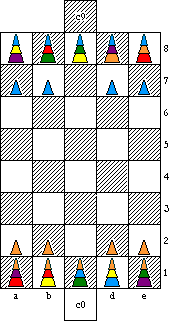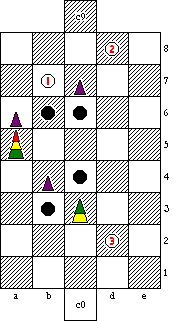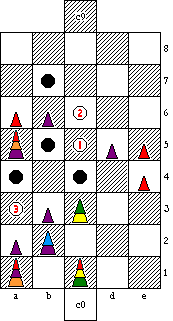Litróf
by Glenn Overby
Board: 5 files by 8 ranks, plus two extra squares at c0 and c9 (the chambers) for a total of 42 squares.
Pieces: Six 15-unit sets of Icehouse pyramids are used: one each of red, orange, yellow, green, blue, and purple. There are five small, five medium, and five large pyramids of each color.
Preparation: Each of the two players plays one of the six colors, determined by agreed means. Each player takes the five small pyramids of their color, four medium pyramids of that color, and one medium and one large pyramid of each of the other five colors. The other 52 pyramids are not used.
Construction: Players now build five towers each for play. A tower is initially comprised of three pyramids, stacked on each other, with a cap (small) on top, followed by a power (medium) pyramid, followed by a movement (large) pyramid on the bottom. No tower may have two pyramids of the same color or size. (There will be four medium pyramids of the player's color which are not in towers.)
Setup: Players place their five towers on their first rank, in spectral order: Rook to the left, then Queen, Bishop, Cardinal, Knight, and Marshal, ignoring the tower which that player does not have. The four medium pyramids are Pawns. They are set up one per square on the second rank, omitting the middle or c file.
Turns: The player of the color first in spectral order goes first: red, orange, yellow, green, blue, purple. Players alternate turns. On each turn the player moves one piece, which may be their own or a neutral piece. After moving, the player then uses the power of the moved piece if it applies. (Note that the power of the Icebox is continuous.)
Chambers: The single space behind each player's first rank (at c0 or c9) is a teleportation chamber. When any piece is moved to the opponent's chamber, first play out all normal power effects. Then that piece moves again, to any empty square on the board, and again uses its power if applicable. A player may never move to their own chamber.
End: When one player is reduced to two or fewer capped towers, that player loses. Should this happen to both players at once, the game is drawn.
Sample Setup

This sample setup shows orange playing blue. The colors of the medium pyramids in each tower represent just one of 44 possible setups for that player. Players may play any pair of colors.
When recording a game, a tower is indicated by the symbol of its power pyramid, then its movement pyramid. A neutral tower is prefaced by a small n.
Captures are indicated in parentheses after the move (x followed by the space from which the piece was captured).
The new status of any tower neutralized by a Diplomat or altered by a Vampire is also shown in parentheses after the move. (e4=nVQ), for example, would mark the de-capping of the Vampire-Queen on e4. By custom, any change to a moving Vampire is listed first.
At the beginning of a game record, note the player's color followed by the five symbols of the power pyramids in left-to-right setup order. The position above might be recorded as HATFIELD (Orange; VSILD) v McCOY (Blue; TVDSL).
About the Pieces
Pawns: A medium pyramid standing alone is a Pawn, owned by the player of that color. Pawns (symbol P) in this game are so-called Berolina or reverse pawns. They move one space diagonally forward, and capture one space straight forward by replacement, exactly the opposite of ordinary pawns. They do not promote or double-step.
Caps: A cap is a small Icehouse pyramid. The color of the cap indicates the owner of the tower. A tower with no cap is neutral, and may be used by either player.
Power Pyramids: A medium Icehouse pyramid indicates a tower's power--the way it captures or otherwise affects opposing pieces. A player uses the power of a tower immediately after moving it. (Exception: the Icebox power is always in effect.) A tower with no power pyramid can only capture an opposing Pawn or Sergeant (by replacement), Trapper (by trapping), or Leaper (by leaping).
- RED (Sergeant/S): Captures an opposing or neutral piece by landing on its space, exactly as in ordinary chess. Remove the captured piece from play.
- ORANGE (Trapper/T): Captures an opposing or neutral piece by moving next to it and trapping it between the Trapper and another friendly (including neutral) piece. The Trapper, its victim, and the trapping ally will form a line of three orthogonally or diagonally. A Trapper may capture more than one piece on its move. Remove the captured piece(s) from play.
- YELLOW (Leaper/L): Captures an opposing or neutral piece by jumping over it, landing on the next empty space beyond. The Leaper may jump over opposing or neutral pieces only in the act of capturing (unless moving like a Knight). A Leaper using a Knight's move is considered to leap over the orthogonally adjacent space incident to the move, for purposes of a possible capture. A Leaper using a Rook's or Bishop's move may leap over and capture more than one adjacent piece on a multi-space move. Remove the captured piece(s) from play.
- GREEN (Diplomat/D): When the Diplomat moves next to one or more opposing towers, it removes the cap from each such tower and makes it neutral. A Diplomat has no effect on an adjacent Pawn.
- BLUE (Icebox/I): While the Icebox is adjacent to any opposing or neutral pieces, those pieces may not move. A neutral Icebox freezes all adjacent pieces.
- PURPLE (Vampire/V): When the Vampire moves next to one or more opposing or neutral towers, it may remove one power or movement pyramid (not both) from one such tower. (A Vampire simply destroys any adjacent opposing Pawns.) Any removed pyramid must be used to replace the corresponding pyramid in the Vampire tower; the original pyramid from the Vampire is then removed from play. (Remember that a tower may not have two pyramids of the same color or size!) A Vampire that replaces its power pyramid with one of another color is no longer a Vampire.
- NB: A tower reduced to one pyramid by actions of Diplomats or Vampires is removed from play.
Movement Pyramids: A large Icehouse pyramid indicates a tower's movement ability. A tower with no movement pyramid moves one space forward or to the side (not backward or diagonally). Towers cannot move onto or over other pieces, except for the Sergeant's capture, the Leaper's capture, and the Knight-like move.
- RED (Rook/R): Moves as a Rook.
- ORANGE (Queen/Q): Moves as either Bishop or Rook.
- YELLOW (Bishop/B): Moves as a Bishop.
- GREEN (Cardinal/C): Moves as either Bishop or Knight.
- BLUE (Knight/N): Moves as a Knight.
- PURPLE (Marshal/M): Moves as either Knight or Rook.
Movement and Capture Examples
The example diagrams below show a Red player moving, playing against Purple. They illustrate the two unusual capture methods and two of the unusual piece movements found in Litróf.

In the diagram at left, Red has a Leaper-Cardinal on a5. Cardinals move like a Bishop or like a Knight. This piece has seven legal moves (marked with circles in the diagram).
Knight-moves: to b7 (number 1, capturing the Pawn at a6), c6, c4, or b3.
Bishop-moves: to b6, b8 (number 2, capturing the Pawn at c7), or d2 (capturing both the Pawn at b4 and the neutral Diplomat-Bishop at c3).
Note that the moves a5-c4 and a5-b3 do not capture the Pawn at b4. The Leaper, when moving like a Knight, is considered to leap over the orthogonally adjacent space for purposes of capture.
Note also that the move a5-e1 would be illegal. A Leaper's capturing move must land in the first empty space beyond the captured piece or pieces.
In the second diagram, at the right, there is a Red Trapper-Marshal on a5. Marshals move like a Rook or a Knight.

The Trapper-Marshal also has seven legal moves.
- By moving like a Rook to position 1 (a5-c5), Red captures the Pawn at d5 by trapping it between the TM at c5 and the Red Pawn at e5.
- By moving like a Knight to position 2 (a5-c6), Red captures the Pawn at d5 (trapping c6-d5-e4) and the Pawn at b6 (c6-b6-a6).
- By moving like a Rook to position 3 (a5-a3), Red makes three captures! The Pawn at a2 is trapped a3-a2-a1. The neutral Icebox-Marshal at b2 is trapped a3-b2-c1. Finally, the Pawn at b3 is trapped a3-b3-c3 using the neutral Diplomat-Bishop.
- Non-capturing moves available include Rook-moves to b5 and a4, and Knight-moves to b7 and c4.
A Sample Game
This short (!) game does not pretend to show best play. It does illustrate the powers and movements of five out of six types, plus the Pawn, and shows how to record some tricky moves.
HATFIELD (Orange, VSILD) v McCOY (Blue, TVDSL) [Detroit, 2002]: 1. ICc1-d3 Pd7-e8 Orange develops the powerful Icebox-Cardinal early. Blue opens a file for the Vampire-Queen. 2. Pa2-b3 VQd8-c7 Orange opens a file for the Vampire-Rook. Blue clears the way for his own Rook, and opens several threats to vampirize. 3. DMe1-c2? LMa8-b6?? A dubious move by Orange is met with ignorance of the threat by Blue. 3...VQc7-c3(c3=IQ, d3=C, xb2, xb3, xd2) is devastating. 4. DMc2-c6(b6=nLM, c7=nVQ) Orange is now just one capture or de-cap from a win! 4 ... nLMb6-d5(xc6) Pretty much forced; the Orange Diplomat must go. 5. nVQc7-d6(d6=nLQ, xd5, xe6, xe7) nLQd6-a3 Orange scuttles the Blue position with three captures, and removes the threat of the neutral Vampire to boot. Blue blocks the Vampire-Rook from creating more havoc. 6. ICd3-b4 SCb8-c6 Blue tries to get something going. 7. SBb1-e4!? SCc6-e4(xe4) Orange leaves unprotected bait; Blue grabs it. 8. Pd2-e3 Threatening to win with a Pawn capture. 8. ... SCe4-d6 9. ICb4-c6! A glorious discovered attack from the nLQ at a3, pinning the Sergeant-Cardinal. 9. ... TRe8-e7 Blocking the winning capture. Moving the neutral Leaper-Queen was another option. 10. ICc6-d7 Resigns All Blue's towers are pinned. [1:0]
About Litróf
This game is inspired by Robert Abbott's classic Ultima and Andrew Looney and John Cooper's more recent Icehouse: the Martian Chess Set
I have long wanted to take Abbott's idea, where every piece captures differently, and merge it with a traditional chess concept of each piece moving differently as well. But the memory work involved caused me to set aside several such ideas; Ultima alone is hard enough on the brain.
In the spring of 2001 I was introduced to Icehouse, its Martian Chess game, and the vibrant community of inventors busily spinning off new games for the cool-looking pyramids. The regular set contains four colors of pyramids: red, yellow, green, and blue. In late fall the manufacturers, Looney Laboratories, came out with two new colors available separately, purple and orange.
Litróf began as a quest to design an Icehouse game using all the colors of the spectrum now available. (Litróf is the Icelandic word for spectrum.) I'm not sure at what point I connected up the fact that a three-pyramid tree could be used to represent owner, power, and movement...but once I did, the game started to take shape. My old Ultima-plus-Chess idea got dusted off. The idea that each piece made up this way would have its own built-in color code for what it did seemed like a big plus.
The game took another major turn when I came to chessvariants.com to research names of variant chess pieces. I had already decided to use the bishop+knight and rook+knight pieces to form a symmetry with the four standard (non-Kingly) pieces, but had forgotten their names. In the sidebar was a link for the contest to design a variant played on a board of 42 squares. This led directly to the design of the current board, which is easy to use a regular chessboard to represent.
Two of the six powers came directly from Ultima: the Sergeant and the Icebox. Two others were inspired by Ultima: the Trapper, which uses an omnidirectional variant of the custodian capture, and the Leaper, which has the potential to leap a whole connected line of enemy pieces instead of just one. And two are original, exploiting the idea that the piece itself can change form by substituting pyramids: the Diplomat and the Vampire.
Then, as I added Pawns to the mix, I realized that the Berolina Pawn, with its propensity for opening up files, was perfect for bringing the three Rook-movers into action. Files are of course longer than ranks on this board.
Other minor decisions, like the asymmetry of the starting colors and the existence of four Pawns instead of five, are products of the mix of pyramids which make up an Icehouse set. Five small pyramids of each color means a limit of five towers per player. How do you get five towers from six colors? Leave one out. But you don't want to always leave the same color out, so what if each player leaves out a different color? Et cetera. And there are four pawns, naturally, since the fifth pyramid of that size and color is in one of your opponent's towers. The c file is the logical one to blank because it can never have a Rook-mover starting on it.
Finally, the existence of 15 different color matchups, with each color having 44 possible opening setups, offers a lot of variety within the basic framework.
And yes, you can play without Icehouse pyramids. A set of three sizes of disk which can be colored and/or written upon works fine. But the pyramids are really neat looking--stackable, transparent, in living color.
Copyright © 2002 by Glenn E. Overby II. All rights reserved. This is an entry in The Chess Variant Pages' contest to design a variant on a board of exactly 42 squares. It is used here by permission.
WWW page created: January 31st, 2002.